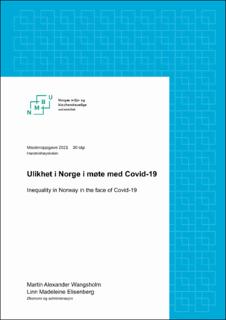| dc.contributor.advisor | Johnsen, Åshild Auglænd | |
| dc.contributor.author | Elisenberg, Linn Madeleine | |
| dc.contributor.author | Wangsholm, Martin Alexander | |
| dc.coverage.spatial | Norway | en_US |
| dc.date.accessioned | 2021-10-14T13:02:38Z | |
| dc.date.available | 2021-10-14T13:02:38Z | |
| dc.date.issued | 2021 | |
| dc.identifier.uri | https://hdl.handle.net/11250/2823089 | |
| dc.description.abstract | Formålet med oppgaven er å belyse hvordan ulikhetene i Norge har blitt påvirket av Covid-19 pandemien. Vi har benyttet et eksplorativt design basert på ulike artikler, statistikk og tabeller.
12. mars 2020 varslet myndighetene i Norge de mest inngripende tiltakene landet har hatt i nyere fredstid med bakgrunn i koronaviruset. Da ble skoler og bedrifter over hele landet stengt ned, og et stort antall ansatte ble permittert. Mobiliteten i samfunnet ble også vesentlig redusert. Vi har sett at det er særlig de unge i 20-årene som ble hardest rammet av permitteringene under krisen, og at sjansen for å bli permittert var høyere for de i lavere inntektsgrupper. Sannsynligheten for bli oppsagt i løpet av de første ukene av koronakrisen var mer enn seks ganger høyere for individer i det nedre inntektsdeksiler enn de øverste. Vi så også at de som hadde høyere inntekt holder seg mer utenfor smittefare som følge av at de i større grad hadde mulighet til å ha hjemmekontor.
Vi har også sett på konkurser i Norge etter koronapandemien inntraff, og det som overrasket var at det ikke var noen vesentlige endringer i konkurser totalt for 2020. Allikevel var det en bransje som skilte seg ut med en økning i konkurser mot tidligere år. Overnattings- og serveringsbransjen hadde i perioden april til juni 2020 det høyeste antallet konkurser for tiårsperioden som ble undersøkt. Dette er en bransje hvor en stor andel av de ansatte enten er studenter eller personer uten høyere utdannelse, og de ansatte har også den laveste gjennomsnittlige årslønnen i Norge. Det var også mye permitteringer innen de bransjene det var konkurser. Vi så videre på utviklingen for Oslo Børs da de mest velstående i Norge eier den største delen av aksjer. På tross av en vesentlig nedgang på over 30 prosent i mars 2020, så har utviklingen ført til nye høyder mot slutten av 2020.
Resultatene vi har fått i oppgaven er at pandemien har rammet den norske befolkningen skjevt. De med lavest gjennomsnittlig årslønn samt de unge har merket det hardest. Samtidig som myndighetenes tiltak har bidratt til å dempe den negative utviklingen i ulikhet, kunne myndighetene allikevel strukket seg enda lengre for å hjelpe individene og selskapene som har slitt mest. Det er mye som taler for at ulikheten mellom de i den øvre og nedre del av inntektsdistribusjonen har hatt en økning under pandemien. | en_US |
| dc.description.abstract | The purpose of this thesis is to shed light on how the differences in Norway have been affected by the Covid-19 pandemic. We have used an exploratory design based on various articles, statistics and tables.
On 12 March 2020, The Norwegian authorities announced the most intrusive measures the country has seen in recent time as a resultat of the pandemic. Schools and businesses all over the country got shut down, and a large number of employees were temporarily laid off. The mobility in the country was also significantly reduced. The younger generation became the hardest affected, and the chance of being temporarily laid off was higher for those in the lower income groups. The probability of getting temporarily laid off during the first weeks of the corona crisis was more than six times higher for the individuals in the lower income brackets than the upper ones. We also saw that those who had a higher income had a greater opportunity to have a home office.
We also investigated bankruptcies in Norway after the coronapandemic occured. Surprisingly, there were no significant changes in total for 2020. Nevertheless, there was one industry with an increase in bankruptcies compared to previous years. Accomodationand the catering industry had in the period of April to June 2020 the highest number of bankruptcies in the ten-year period we examined. In this industry a large proportion of employees either are students or people without higher education, and the employees also have the lowest average annual salary in Norway. There were also a lot of temporarily layoffs in the industries with alot of bankruptcy. We looked further at the development for the Oslo Stock Exchange as the most prosperous in Norway owns the largest share of stockshares. Despite a significant decline of over 30 percent in March 2020, the development of stockprices has led to new heights towards the end of 2020.
The results we have obtained in this thesis are that the pandemic has affected different between the Norwegian population. Those with the lowest average annual salary as well as the young have been affected the hardest. Measures of the authorities have helped against the negative development in inequality, though the authorities could still have gone even further. There are alot of evidence suggesting the inequality between the upper and the lower part om the income distribution has had an increase during the pandemic. | en_US |
| dc.language.iso | nob | en_US |
| dc.publisher | Norwegian University of Life Sciences, Ås | en_US |
| dc.rights | Attribution-NonCommercial-NoDerivatives 4.0 Internasjonal | * |
| dc.rights.uri | http://creativecommons.org/licenses/by-nc-nd/4.0/deed.no | * |
| dc.title | Ulikhet i Norge i møte med Covid-19 | en_US |
| dc.title.alternative | Inequality in Norway in the face of Covid-19 | en_US |
| dc.type | Master thesis | en_US |
| dc.description.localcode | M-ØA | en_US |

